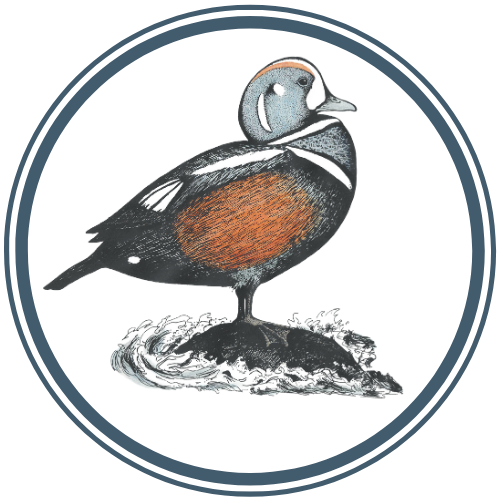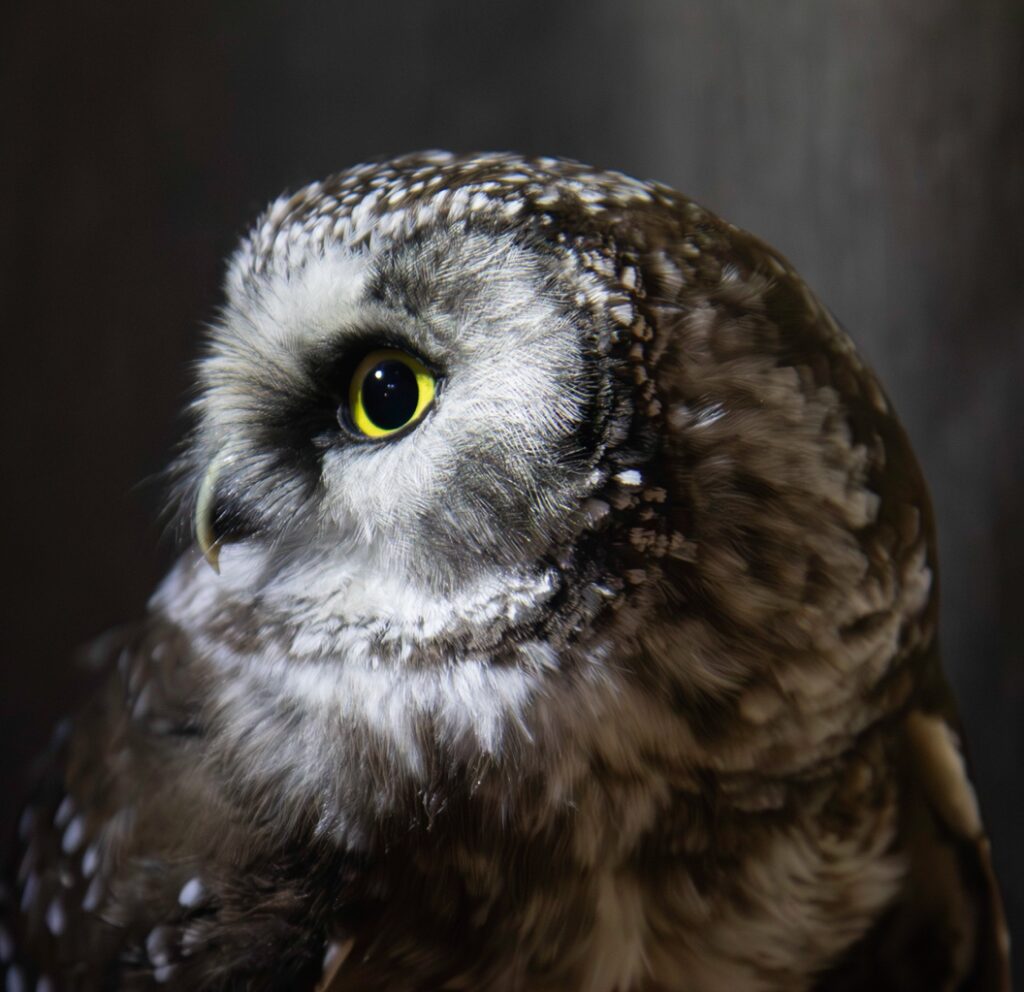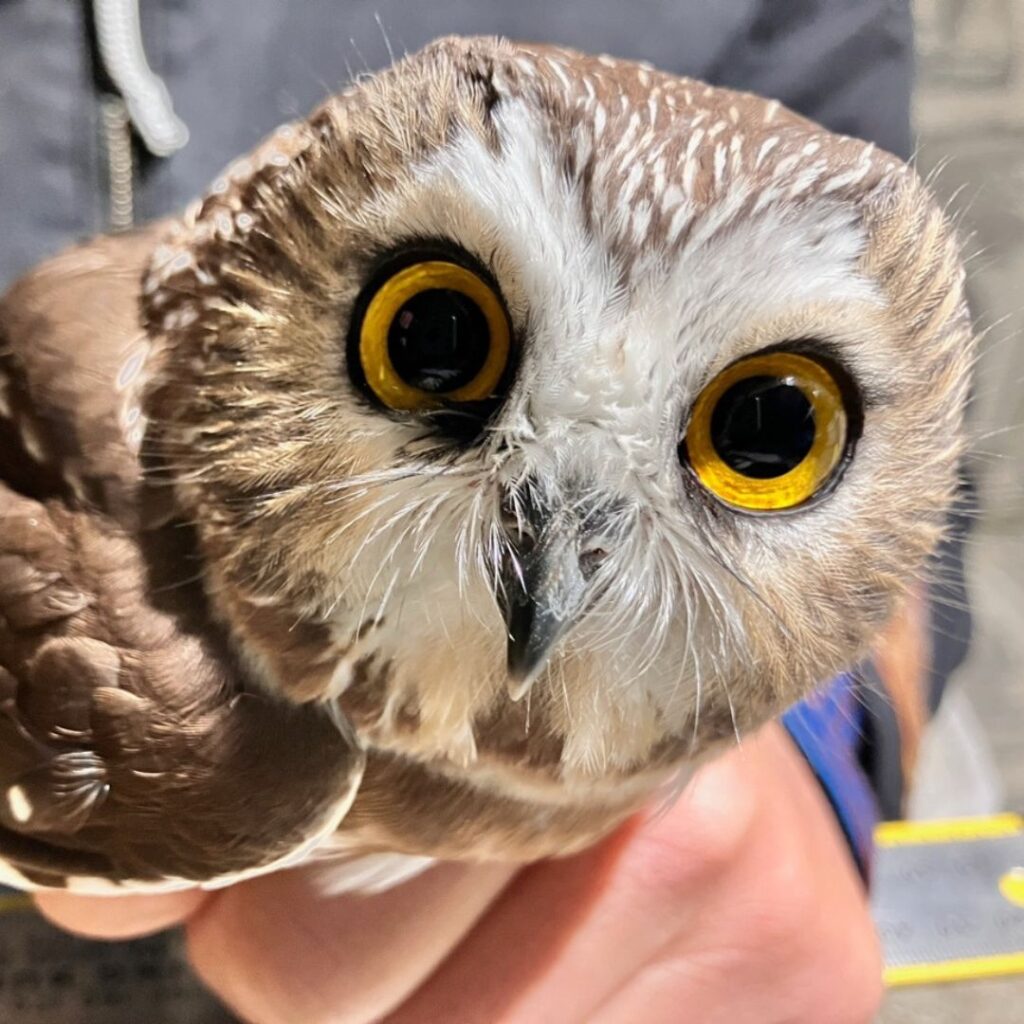November 2025
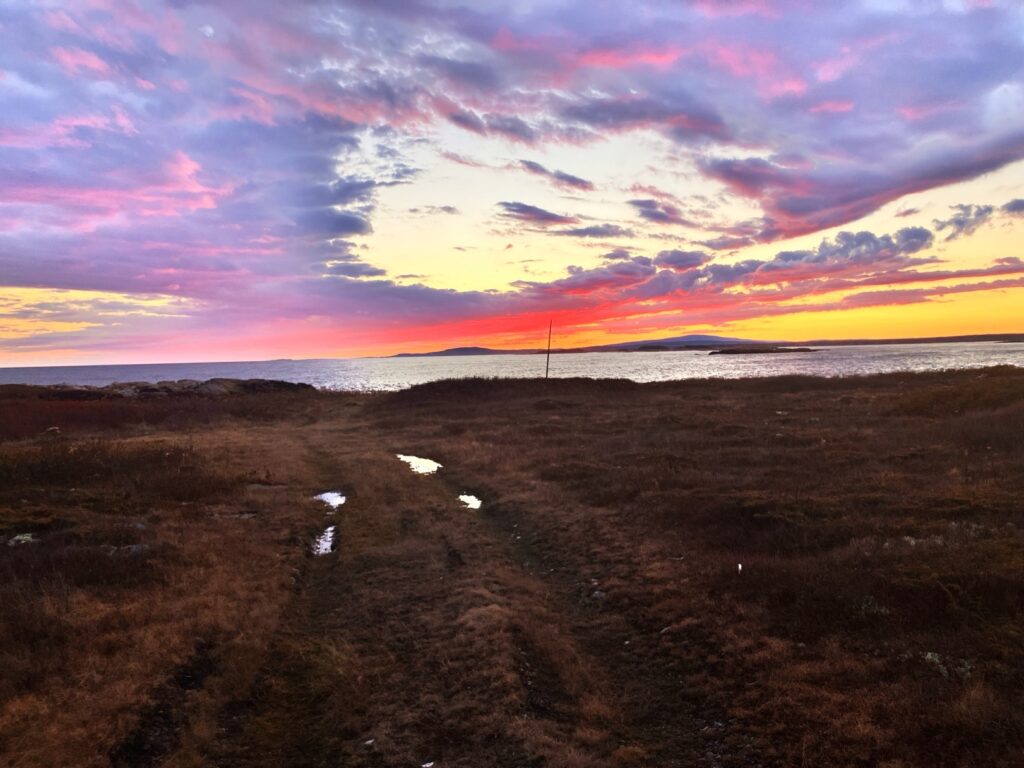
The view over the ocean as the sun set on our last night of owl banding, looking out from Petit Manan Point towards Schoodic Peninsula.
Most of the leaves have fallen from the trees, the winds push through the bare branches, and our late nights with the owls have come to an end. We have packed up our banding pliers, wing rulers, and measuring scale, un-wired our solar panels, and taken down our mist-nets. Like the owls, we too have migrated for the winter.
Before all of our disassembling and packing up, we got to experience our final weeks of owling, with the ups and downs of unpredictable late-fall weather and the waning of migration. There were quite a few wet and windy nights when we stayed home and entered the data we have spent the season collecting, but we also had nights when the winds and the stars aligned. By the final net check of our final night of mist-netting, we had captured a total of 375 Northern Saw-whet Owls for the 2025 season! This absurdly round number of owls is the third-highest count of birds to hit the nets here at Petit Manan Point, and it well exceeded all of our expectations.
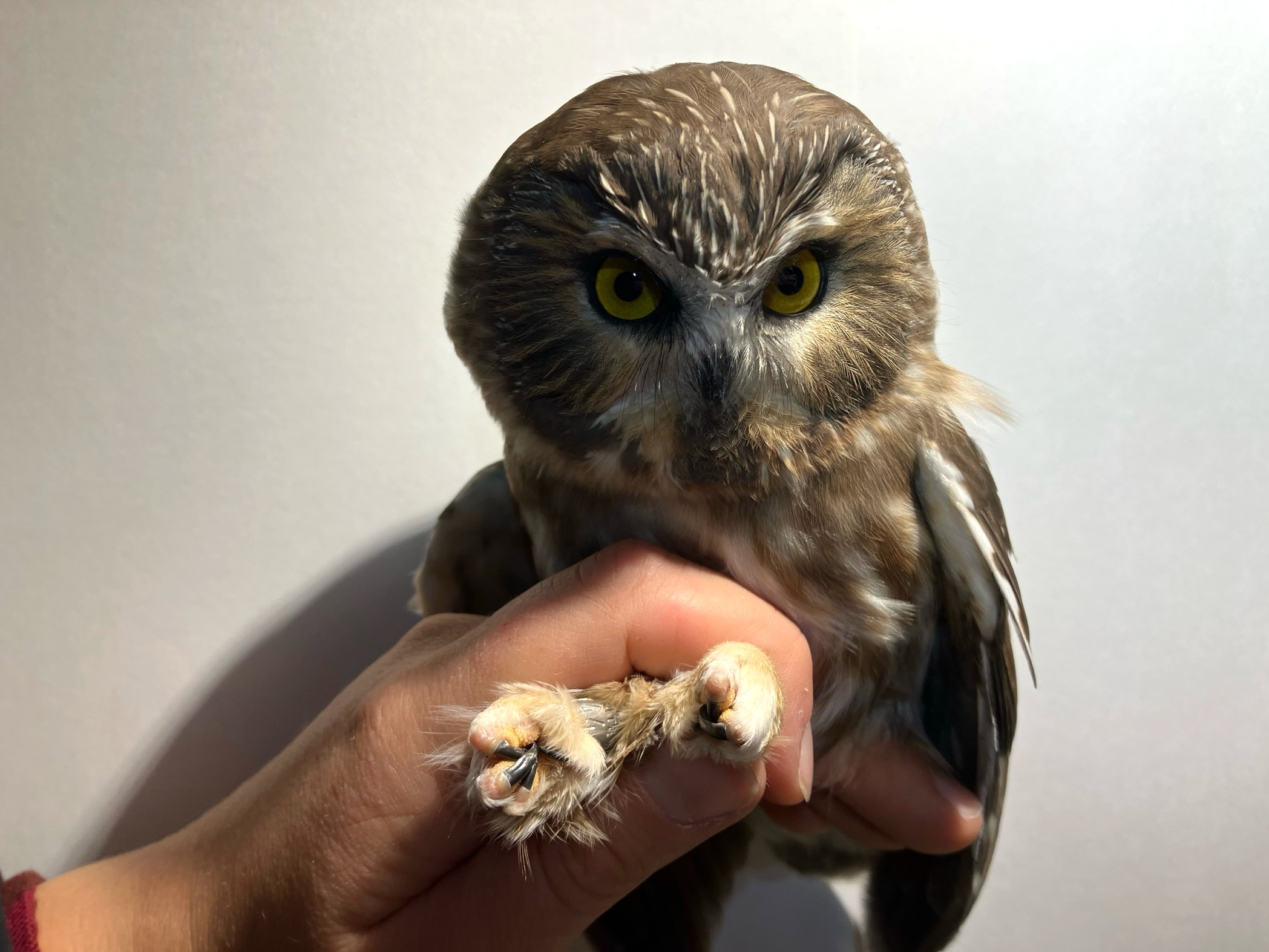
The 315th Northern Saw-whet Owl of the season, who broke last year’s third-place record of 314 owls for the season. We were able to capture 60 more birds, ending the fall with 375.
This surprisingly high volume of birds did break down into the proportions we expected to observe, between adults and hatch-years, as well as females and males. The majority of our owls were hatch-years, making their first migration South after fledging from their nests just this past summer. We captured 261 hatch-years and 114 adult birds. At 70%, this proportion of hatch-years was a drop from the 86% of birds that we banded in 2024. We expected this decrease, as a representation of fewer owls hatching this past summer, and higher numbers of owls who hatched last summer migrating for the second time. Accordingly, the number of second-year birds jumped from just 26 in 2024 to 73 birds this year.
The proportion of female to male birds stayed relatively the same between seasons. We caught 289 females, 27 males, and 59 birds whose measurements fell between those that are definitively one or the other, giving us 77% females, 7% males, and 16% unknown owls. These percentages fit with the theory that females tend to migrate far from their breeding grounds in search of prey to bulk up over the winter before expending energy laying eggs when they return in the spring, while males stay much closer to those breeding grounds, so they can stake out their territory. This divergence in migratory strategies could explain the overwhelming numbers of female owls that make up our total.
While almost every owl we captured was unbanded, every so often our headlamps caught the glint of a metal band as we untangled a bird’s legs from the net. Two of these recaptured owls were banded as hatch-years here at Petit Manan Point in 2024, returning to the same nets a year later. Of the three birds banded at other stations in previous years, two were banded as hatch-years in 2024, one at Hawk Mountain in Pennsylvania and one at the Braddock Bay Bird Observatory near Rochester, New York. The third bird was banded as a second-year female at Lamb’s Knoll in Maryland, making her a four-year-old bird this fall. Additionally, one of the second-year birds we caught and banded on 4 October was recaptured at the Mark Blazis Research Station at Eager Woods in Berlin, Massachusetts on 18 October. Though these recaptured birds are few and far between, they can give us a window into how the birds are moving between banding stations and across the country.
In addition to our 375 Northern Saw-whet Owls, we were lucky enough to handle a few other owl species. We captured two graceful Long-eared Owls, with plumage of silken tree bark, who hissed like cats as we extracted them from the nets. Both came to the point in the first half of the season, one on 1 October and the second on 17 October. Just a few nights later, on 21 October, we caught a hatch-year Barred Owl, with the liquid black eyes of a seal and a startlingly yellow bill. We were thrilled to have gotten to experience three different owl species over the course of our season.
The late fall nights had one more surprise for us, though. On 25 October, after a few slow nights in a row, we were excited to find a steady flow of saw-whets hitting the nets. As usual, we took turns sitting out at the nets, switching out every hour or two. My feet were getting cold by the time I saw Tracey’s light beaming through the trees. I looked in the opposite direction, to the far end of the net lane, and saw a saw-whet suspended there; the bird must have flown in within the previous few minutes. Tracey’s light had paused at the first net, so I knew another owl must have just come in as well. After taking my bird out of the net, I walked down to meet her, turning the corner of the net lane along the way. Once her bird was also out of the net and safely in a bag, I told her I would wait to head back to the banding trailer until she had walked back up the stretch of nets I had just walked down, just in case another owl had come in. As we had suspected, a third bird had hit the net just past the corner in that brief time. As the owl struggled in the bottom section of the net, Tracey reached into the net pocket to extract it. Her fingers wrapped around the bird’s legs, feeling how thick, powerful, and undeniably poofy they were. As she carefully gathered the owl in her hand, the bird swiveled its large facial disc towards her, revealing slaty gray feathers, pale yellow eyes, and the distinctive bicolored bill of a Boreal Owl! In disbelief, we both marveled at a species we were now lucky enough to see not once, but twice. Last fall, after we had released the single Boreal Owl we captured, we all did so with the knowledge that we might never get to touch this elusive species again in our lives. What an electric thrill, then, to once again have a Boreal Owl in the banding trailer!
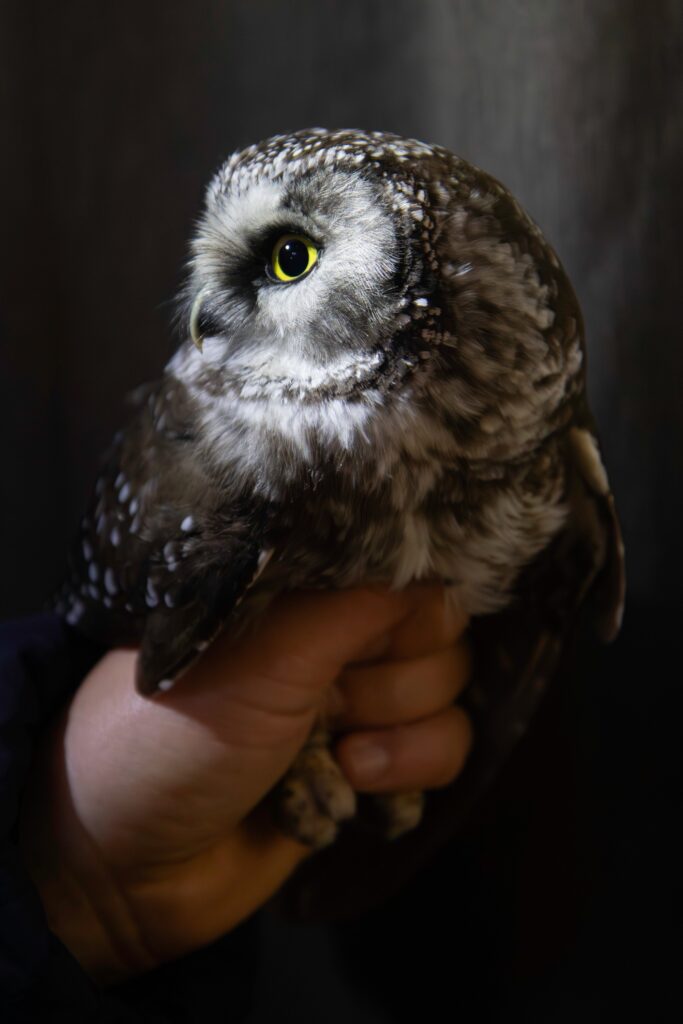
The Boreal Owl, captured on 25 October. Photo courtesy of Percy Ulsamer.
We banded the owl, took our usual measurements, then recorded some additional measurements to help us determine whether the bird was a male or female. Based on those measurements, we identified this rare owl as a female, only the fifth Boreal Owl ever banded in the state of Maine. Superficially, a Boreal Owl is similar to a saw-whet, but up close, this bird was utterly different. There was something more than just her cooler color tones, her larger proportions, and the incredible density of feathers down her legs that made her taloned feet resemble paws. It is as if she carried a mantle of magic, a whisper of the boreal forest’s shaded mystery down to us here, where the pines open out onto the rocky coast.
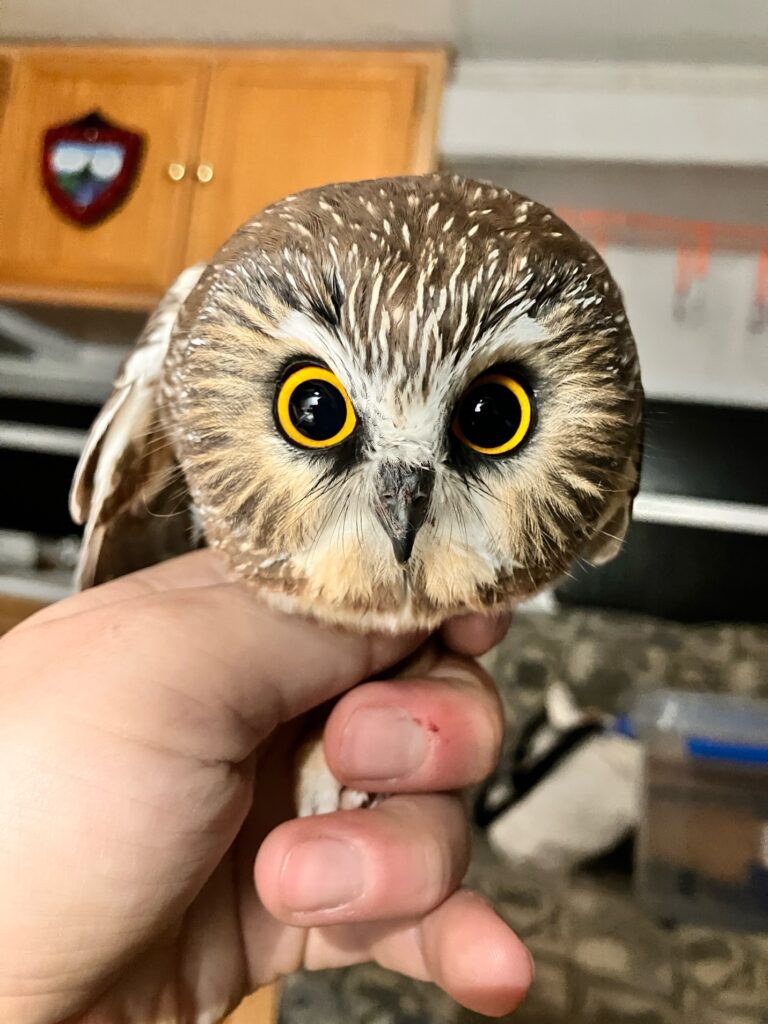
The final Northern Saw-whet Owl captured during the 2025 fall banding season.
As our season wound down, our last week of mist-netting was filled mostly with high winds and rain. We held out hope for one final night, and a few more birds. On 8 November, we opened the nets for the last time. Each saw-whet we caught felt as full of forest magic as the Boreal Owl, and as we released each one, it was with a sense of finality. By the middle of the night, we had caught six birds, and the hours went by with empty nets. Finally, we walked along the nets at 3am, ready to close everything down. There at the end of the net lane was a single saw-whet. The last bird of the season, appearing out of the dark skies when we least expected it, felt like an embodiment of our whole season at Petit Manan Point. All we had to do was stay awake, keep our fingers warm, and wait for the wonders of owl migration to drop down to us out of the starry skies. The birds spent the fall doing the incredible work of avoiding predators, hunting for small rodents, and taking off, night after night, to fly ever farther from their breeding grounds, many of them for the very first time. In briefly interrupting that flight, the two of us, along with all of the lovely volunteers and visitors who helped us over the course of the season, got to be some of the only humans to ever look into these owls’ eyes and see them looking back at us, before they flew out of our hands.
- by Coco and Tracey Faber
